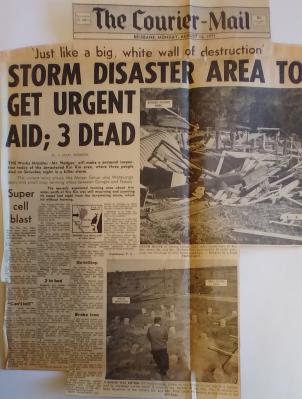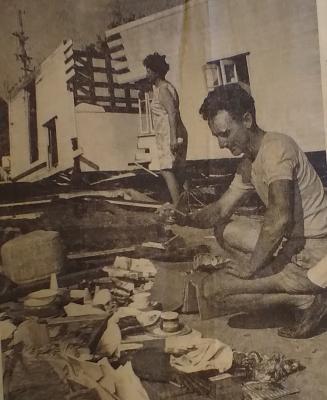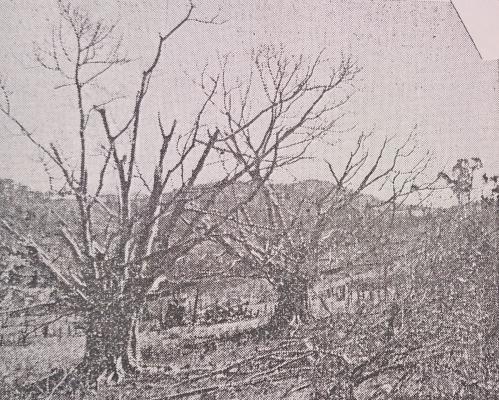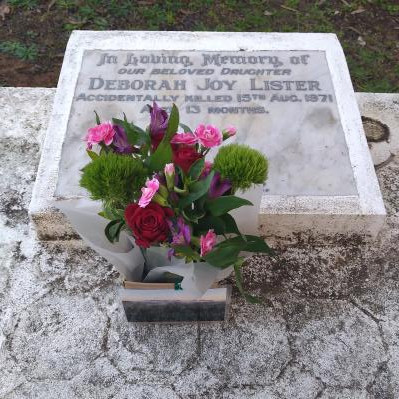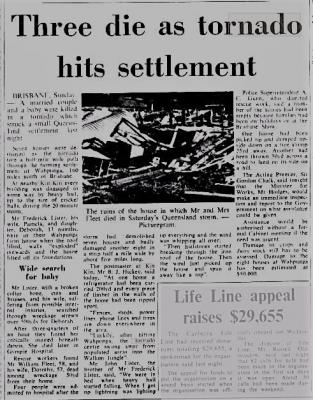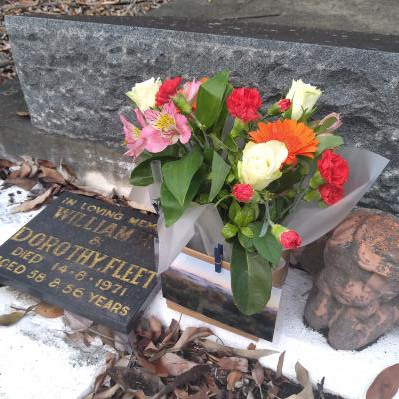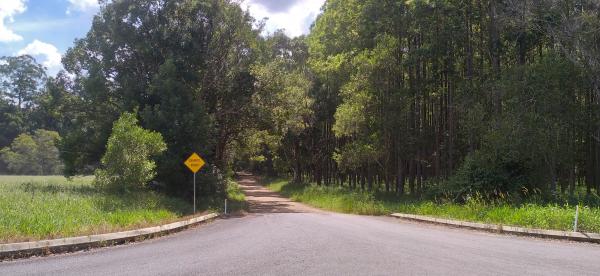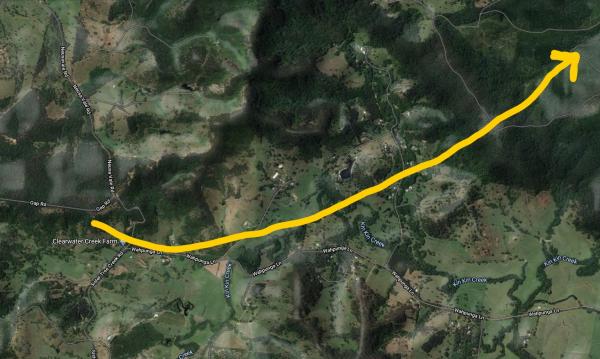Precede
It came from the west without warning.
A storm system which viciously transformed itself into a tornado and left three people dead or dying and dozens of others homeless.
And after a few minutes of sheer terror for those caught in its path, it had gone, evaporating into the night sky.
The date was Saturday 14 August, 1971.
Some call it the worst day in Kin Kin’s history. A beautiful young girl and a middle-aged couple were killed. Eight homes were completely destroyed. Dozens of others were damaged. The community was shattered.
Nick Thompson looks back on the tragedy 50 years ago which sits in the record books as Australia’s deadliest tornado.
# # #
The day started like any other during mid-winter in the Noosa hinterland. Cool with blue skies above the rolling green hills surrounding the little town of Kin Kin.
The locals were working in the fields, tending their vegetables and looking after the dairy herds.
There were no warnings. This was a time without smart phones and computers, weather radars or emergency broadcasts.
Even Mother Nature chose not to send any of its tell-tale signals. The birds kept singing, the sky remained within its normal colour range. Everything was normal.
Ray and Vera Grady had been in their bean fields on their Wahpunga Lane farm but had quit for the day when they first noticed the wind had started to build.
Along with Vera’s father Harold Petersen they settled down to watch some TV after dinner when, without warning, the power went out. They could hear the wind growing stronger but still thought little of it. Vera’s father decided to drive back to his own home.
He returned shortly after. He’d come up against a tangle of power lines and roof sheets on the ground and realised it was too dangerous to continue.
Not far away, neighbour Mavis Cochrane remembers her husband Alan having to press his weight across a door which kept blowing open.
Arland Ussher recalls: “We lost power on Moran Group Road very early in the evening. The storm did last for a reasonable time as a rain storm but with the tin roof we couldn’t really hear much more than that.
“While it was a ‘wild storm’ we did not think more of it than that.“
For all of these long-term locals, the storm seemed no worse than countless others they had all experienced before.
But as they lay in their beds, they had no idea that only a few hundred metres away their friends and neighbours were dying and whole houses were being smashed and torn apart.
It’s one of the cruelest acts of any tornado.
The random nature of the violently twisting black funnel carving its way through anything in its path but leaving other objects only a handful of metres away virtually untouched.
And so it was in and around the northern districts of Kin Kin that night.
A Storm With Unimaginable Ferocity
The first anybody knew of the disaster was when the first survivors of the tornado began to emerge from the dark. Most of them were in a total state of shock. Their clothes had been torn off, bones were broken, and some were covered in blood.
The late Henry Treichel recalled afterwards: “We’d had a very rough storm and I had just gone to bed … when a light came up the hill.
“It was the two Lister boys – John and Fred. Both were injured and in deep shock. We got them inside and put some clothes on John and a blanket around Fred.
“They said our houses have been blown away.
“I put them in my station wagon and when we got to the bottom of the hill, John, who was coming out of shock, said: ’We never found the baby Mr Treichel’.
A Beautiful Child
“I did a quick double take. The wives were in shelter so the first priority had to be the baby. I knew this child, she was a beautiful child.
“Fred’s home was completely wrecked … there were no two boards nailed together. Utter devastation. It was still raining lightly with hail and our only light to help in the search was from a torch with a flat battery and the flickering lightning.
“After 10 minutes or so looking I found the little girl who was still alive though nearly frozen
“I called the boys who were further down the hill and Fred wrapped her in his blanket. I carried her as Fred had a broken collar bone.
“The station wagon had become hopelessly bogged so we had to walk along the main road.
Eventually the survivors came across another neighbour with a ute who took them into Kin Kin before an ambulance carried them on to hospital.
The little girl, Deborah Joy Lister, was just 13 months old. She died in Gympie Hospital the next day. Her parents, Fred and Pam Lister, were both badly injured and were also admitted, along with Beverley Lister.
Vera Grady still struggles to talk about the death of Debbie Lister, the beautiful little girl she remembers dressed in pink at a party only a week before the tornado.
The memories are still raw, even after 50 years.
Destructive Path
The storm developed somewhere west of Gympie earlier in the evening, strengthening as it made its way towards the coast.
As it crossed the Woondum Range, the high ridge of hills between Gympie and Noosa, it dramatically intensified, callously creating the deadly tornado within.
While it struck in the dark, the tornado’s track through the fields and forests could be easily seen the next day. It had ploughed a wide furrow running parallel to the Kin Kin Creek and through the Wahpunga district.
Everything in its path had been destroyed.
Then it had crossed another low-lying ridge east of Moran Group Road before tearing into the Buckley Road area, where it smashed through the two houses owned by the Lister brothers, Fred and John, on their shared property.
In its final major destructive act, it completely capsized the home of dairy farmer Des Robinson, rolling the house down a hill where it came to rest against a tree.
Trail Of Destruction
Today, Moran Group Road is a meandering leafy lane with none of the scars wreaked by the tornado left visible after 50 years of re-growth. The damaged houses have been replaced or repaired, the trees are back.
But on the morning of August 15th 1971, the residents emerged from their homes to find a landscape they could barely recognise.
Bryant Ussher, only 10 years old at the time, remembers his family’s house at the southern end of Moran Group Road was untouched by the storm during the night.
But when he walked out with his father Arland the next morning, they soon realised they were entering a disaster zone which began only a few metres from their own front gate.
“It looked like a couple of [bull]dozers had gone up the hillside with a chain between them and just cleared a road. It was so clearly defined where the storm had gone through,” Bryant recalls.
A huge fig tree had been completely stripped bare on one side but left wholly intact on the other.
Arland Ussher recalls meeting a neighbour, Jim Warren, who asked him to get his tractor to help clear the fallen trees and debris.
One of the first properties they reached belonged to Bill Fleet (58) and his wife Dorothy (56). Their house had been completely demolished and it was only after a search that their bodies were found 30 metres away.
To the south, Ray and Vera Grady emerged from their home and walked up into the fields to see how their crops had fared. They still had no idea of the enormity of the disaster just a few hundred metres away.
Then Ray looked across the valley and realised something was wrong. And then it hit him – the Fleets’ house was missing.
Henry Treichel recalled: “They were a popular couple and the people who found them the next day said they never had a chance.“
Des Robinson was among the luckiest of the tornado survivors.
Mr Robinson, a dairy farmer, had taken shelter in the laundry as all the windows in the house began to smash. After that he remembered being hit on the head by a washing machine as the entire building was lifted off its base and flipped completely over.
He was thrown out into the garden where he was able to find shelter behind a water tank.
In a stroke of fortune, Mr Robinson’s wife and two sons were away for the weekend. Along with a number of others in the district, they had gone to Brisbane where the Ekka was in full swing.
The Aftermath
For those who did survive, new challenges awaited. Many had lost everything they owned and had no insurance.
This was a storm with long lasting consequences, even for those who survived.The state government made $500 payments to a handful – a payout equivalent to less than $6000 today.
Debbie Lister now lies in Pomona Cemetery. A simple headstone states she was accidentally killed on the 15th of August 1971 – the date on which she succumbed to her injuries in Gympie Hospital.
The Fleets are buried together near other family members in the Balmoral Cemetery on the south side of Brisbane.The Kin Kin Community Group delivered floral tributes to the final resting places of the victms last Saturday, the 50th anniversary of the tragedy.
Each had a photograph of the Kin Kin hills and the simple message: “Taken from us 50 years ago but Kin Kin will never forget. Rest in Peace.“

